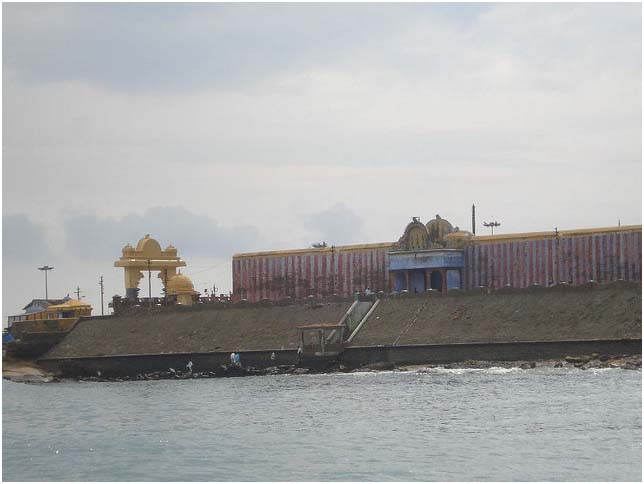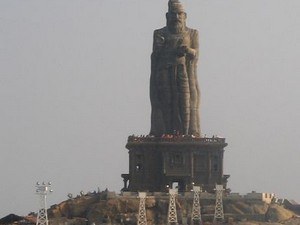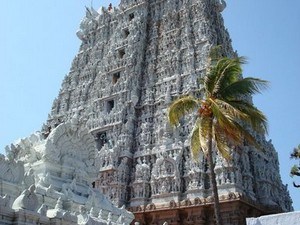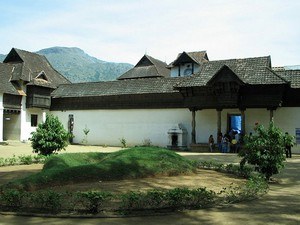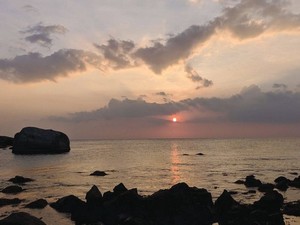Kumariamman Temple, Kanyakumari - Timings, Festivals, History, Darshan, Pooja Timings
Photo Credit: Flickr
 #3 of 35 Places to Visit in Kanyakumari
#3 of 35 Places to Visit in Kanyakumari
 Distance (From Kanyakumari Station): 1 Kms
Distance (From Kanyakumari Station): 1 Kms
 Trip Duration (Including Travel): 1 Hour
Trip Duration (Including Travel): 1 Hour
 Transportation Options: Cab / Auto / Walk/Trek
Transportation Options: Cab / Auto / Walk/Trek
 Travel Tips: None
Travel Tips: None
About Kumariamman Temple
At a distance of 1 Km from Kanyakumari Bus Station, the Kumari Amman Temple is an ancient Hindu temple situated in the Kanyakumari town of Tamilnadu. It is one of the popular pilgrimage sites in Tamil Nadu, and among the top places to visit in Kanyakumari. Also known as Bhagavathi Amman Temple, the Kumariamman Temple is dedicated to Devi Kanya Kumari, an adolescent girl child form of Goddess Parvati. The diety is also known as Shree Baala Bhadra or Shree Baala. Kanyakumari Temple is one of the 51 Shakti Peethams. It is believed that the right shoulder and (back) spine area of Sati's corpse fell here creating the presence of kundalini Sakthi in the region. This is one of the prime places to visit as part of Kanyakumari tour packages.
History of Kumariamman Temple
The Kumari Amman Temple, located in Kanyakumari and dedicated to the virgin goddess Devi Kanyakumari, is thought to be over 3,000 years old. It is positioned at the southernmost point of India, where the Arabian Sea, Bay of Bengal, and Indian Ocean converge. According to mytology, Sage Parasurama is credited with the temple's consecration and is also believed to have established the first Durga temple. The present temple was built during the rule of the Pandya dynasty. The temple is overseen and managed by the Hindu Religious and Charitable Endowments Department of the Tamil Nadu Government.
Mythology of Kumariamman Temple
According to the legend, the demon Banasura once imprisoned all the gods in a cruel manner. Due to a boon he received, he could only be defeated by a virgin girl. In response to the prayers and pleas of the gods, Goddess Parasakthi transformed into Kumari, a virgin girl, to vanquish the demon. Over time, Lord Shiva fell in love with Kumari, and preparations for their celestial wedding commenced. Sage Narada, aware that Banasura could only be killed if the Goddess remained unmarried, attempted to cancel the wedding through various means. When his efforts proved futile and the wedding was scheduled for midnight, he devised a cunning plan. On the day of Lord Shiva's journey from Suchindram to Kanyakumari for the wedding, Sage Narada transformed into a rooster and crowed to falsely signal the arrival of dawn. Misled by the sound, Lord Shiva returned, believing the auspicious time for the wedding had elapsed, while the Goddess awaited him in vain. Ultimately, the Goddess chose to remain unmarried.
Later, when the infatuated demon Banasura attempted to forcibly marry her, she defeated him with her Chakra Gadha, thereby liberating the gods from his grasp. Subsequently, Banasura sought the Goddess's mercy and prayed for forgiveness for his sins. The Goddess granted him forgiveness and blessed the waters of the holy confluence. It is said that anyone who bathes in these waters will cleanse themselves of their sins.
Architecture of Kumariamman Temple
The Kumari Amman Temple in Kanyakumari features an architectural style that harmoniously combines Dravidian and Kerala influences, reflecting the area's rich history and cultural heritage. Enclosed by a tall stone wall, the temple exudes a sense of grandeur and historical significance. The main entrance to the temple complex is marked by a stunning gopuram on the northern side, embellished with detailed sculptures and vibrant hues. The eastern gate remains closed on most days, only opening for special occasions, including new moon days during the months of Vrischikam, Edavam, and Karkidakam.
The principal deity of the temple, Devi Kumari, is oriented towards the east. She is depicted in a standing position, holding an Akshamala (a garland made of Rudraksh beads) in her hands. A lion figure at her pedestal symbolizes her identity as Adi Parashakti. It is believed that the goddess alleviates mental rigidity, and many women visit her temple to pray for marriage. The deity's nose ring is renowned for its remarkable brilliance, with numerous legends associated with it. One such tale suggests that the diamond nose ring was sourced from a King Cobra. According to a popular story, the ring's dazzling reflection was so intense that a sailor mistook it for a lighthouse, leading to his ship crashing against the rocks. This incident is said to be the reason the eastern door of the temple remains closed, only opening five times a year for special events.
Within the temple complex, there are several other shrines dedicated to deities such as Lord Surya Deva, Lord Ganesh, Lord Ayyappa Swamy, Goddess Balasundari, and Goddess Vijaya Sundari. The temple also features a hall supported by four pillars, each producing the sounds of a Veena, Mridangam, flute, and Jalatarang, respectively.
Festivals of Kumariamman Temple
The Karumariamman Temple in Kanyakumari celebrates various festivals throughout the year. Mandaikadu festival held in the month of Masi (February/March), and Navaratri Festival in October/November are the significant festivals celebrated in Kanyakumari, with devotees from all over the region participating. Chaitra Purnima in April and the Vaisakha festival in May/June are the other major festivals celebrated here.
Kumariamman Temple Dress Code & Other Restrictions
When planning a visit to the Kumari Amman Temple in Kanyakumari, it is recommended to adhere to modest clothing that covers your upper arms and legs as a sign of respect. Men are encouraged to wear a dhoti or pajama paired with an upper garment, as well as formal trousers and shirts. Women may opt for a saree, half saree, or churidhars. Men need to remove their shirt before entering the sanctum sanctorum of the temple. It is advisable to refrain from wearing contemporary attire such as mini-skirts, jeans, shorts, and sleeveless tops while on the temple grounds.
Non-Hindus are welcome to explore the temple complex and appreciate its architectural beauty; however, access to the sanctum sanctorum may be restricted.
Kumariamman Temple Timings
Monday: 4:30 AM - 12:30 PM & 4 PM - 8:30 PM
Tuesday: 4:30 AM - 12:30 PM & 4 PM - 8:30 PM
Wednesday: 4:30 AM - 12:30 PM & 4 PM - 8:30 PM
Thursday: 4:30 AM - 12:30 PM & 4 PM - 8:30 PM
Friday: 4:30 AM - 12:30 PM & 4 PM - 8:30 PM
Saturday: 4:30 AM - 12:30 PM & 4 PM - 8:30 PM
Sunday: 4:30 AM - 12:30 PM & 4 PM - 8:30 PM
Kumariamman Temple Entry Fee
General Entry is Free
Special Darshan available for Rs. 20
Best Time to Visit Kumariamman Temple
The best time to visit Kumari Amman Temple is from October to March, while the peak season is from November to February. Mandaikadu festival held in the month of Masi (February/March) and Navaratri Festival in October/November offers a remarkable opportunity to immerse oneself in the temple's lively ambiance, drawing thousands of devotees. It is advisable to avoid visiting the temple in the peak summer months from April to June, as temperatures can rise significantly, complicating outdoor activities.
How to Reach Kumariamman Temple
Trivandrum Airport serves as the closest airport, located approximately 97 kilometers from Kanyakumari. The Kanyakumari Railway Station is well-connected by rail to major cities such as Chennai, Bangalore, Mumbai, Trichy, Madurai, Hyderabad, Delhi, Trivandrum, Kochi, Kolkata, and Jammu. Additionally, there is excellent bus service linking Kanyakumari to Trivandrum, Madurai, Trichy, Tirunelveli, Pondicherry, Kochi, Chennai, and Bangalore. The Kumari Amman Temple, situated about 1 kilometer away, can be accessed on foot or by hiring an auto-rickshaw from either the Kanyakumari Bus Stand or the railway station.



